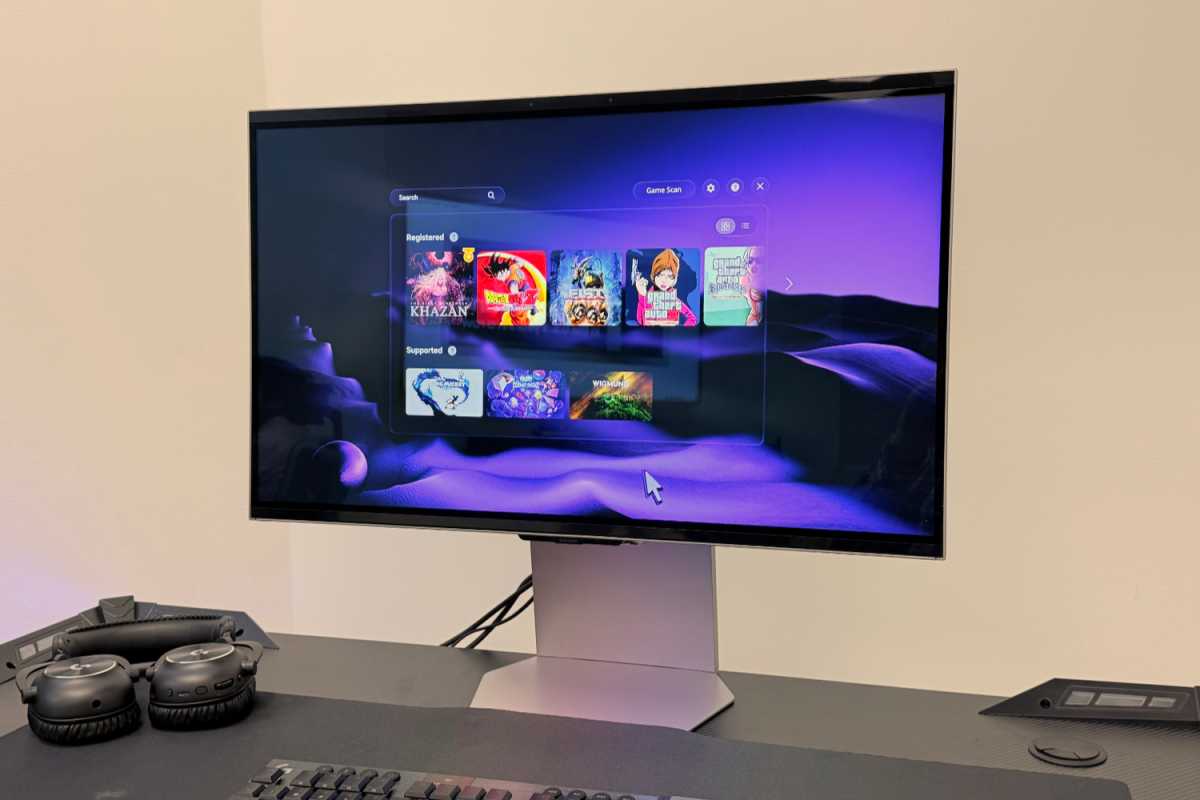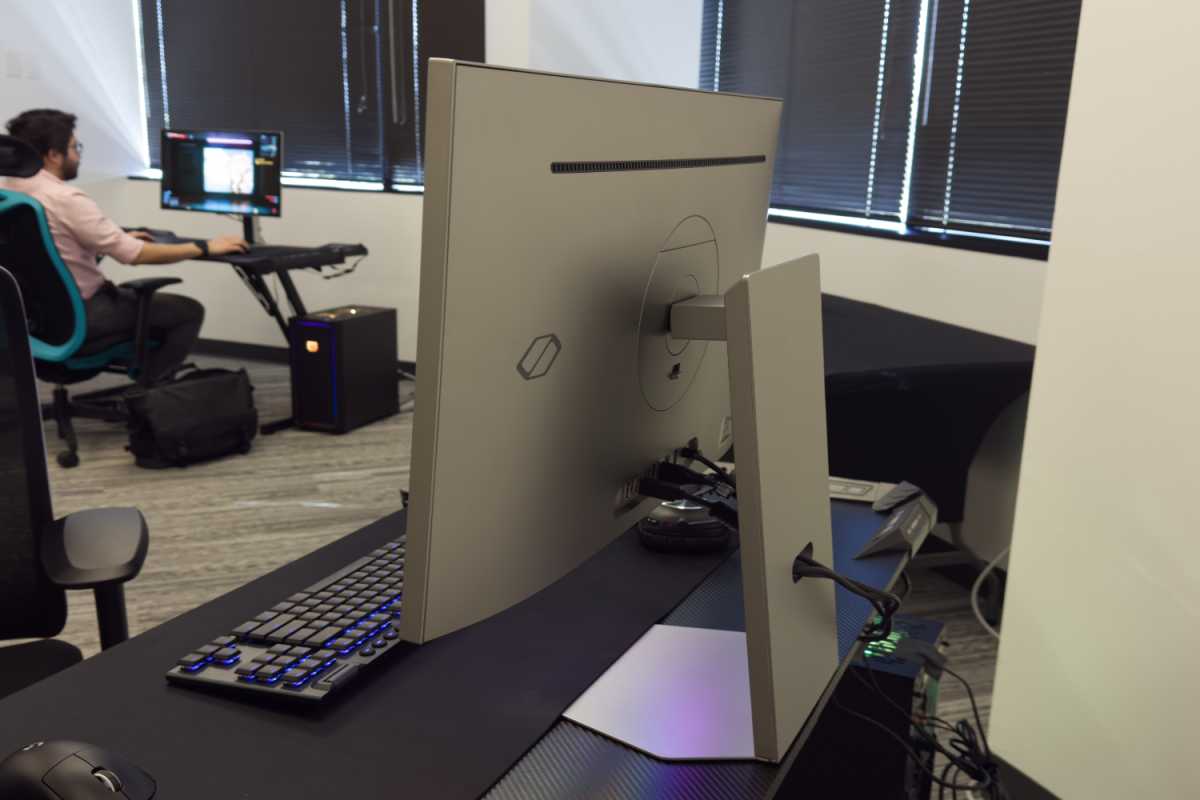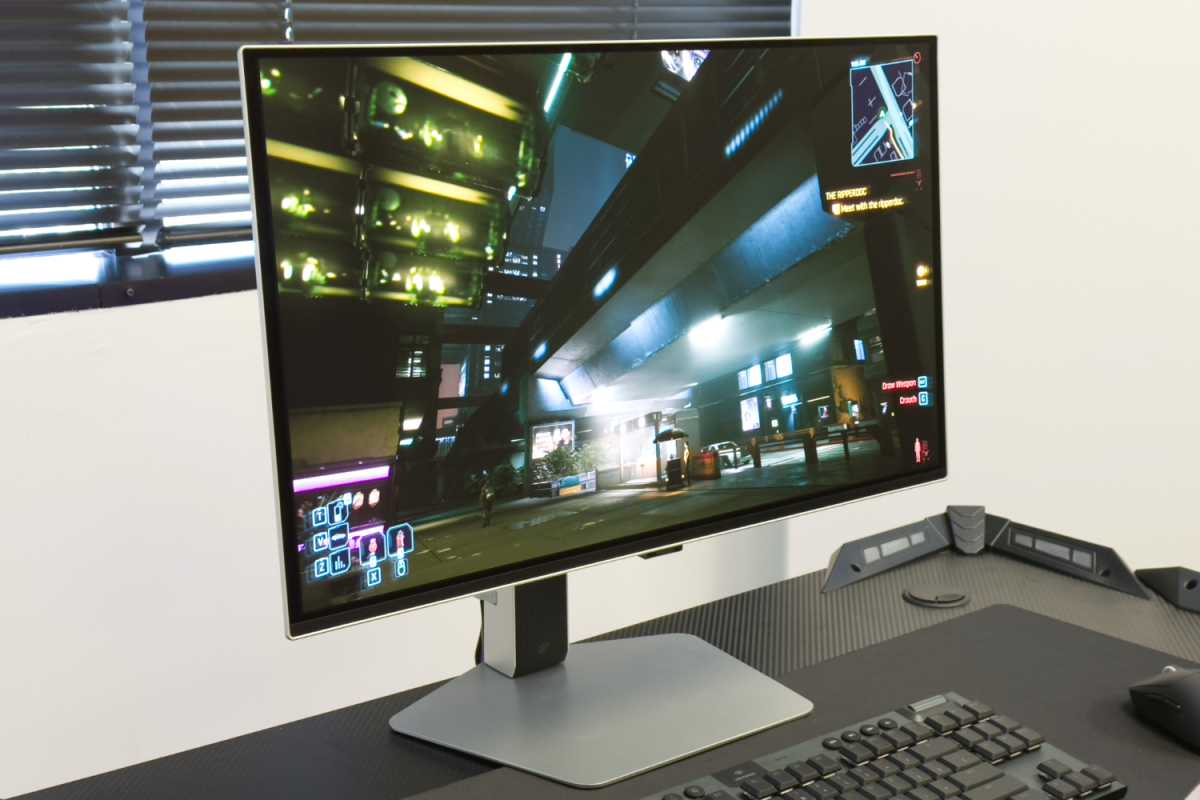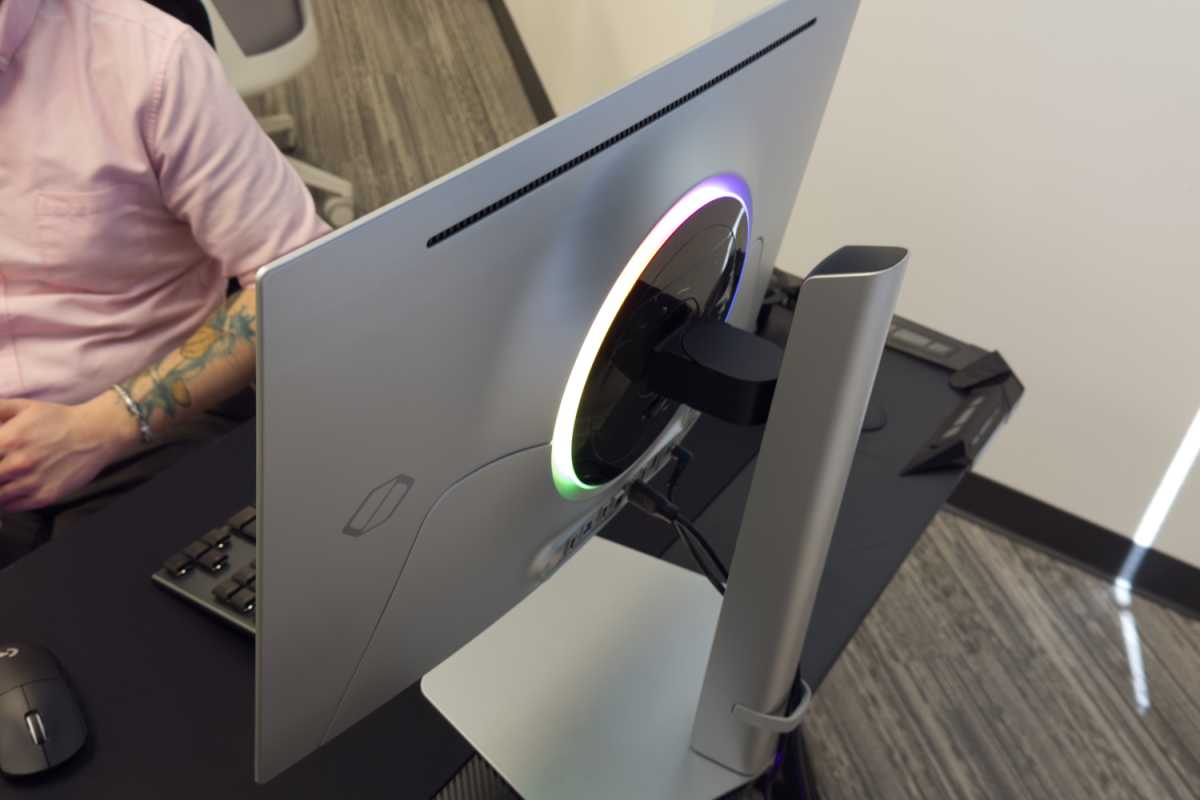- Регистрация
- 17 Февраль 2018
- Сообщения
- 36 050
- Лучшие ответы
- 0
- Баллы
- 2 093
Offline
Back at CES 2025, Samsung revealed their latest monitors including the much-anticipated 27-inch 4K 240Hz OLED display as well as the more niche—but still exciting—Odyssey 3D-without-glasses monitor.
Samsung wasn’t ready to talk details at CES, but now they’ve lifted the veil and I was able to go hands-on with their newest gaming displays, including the Odyssey 3D (G90XF) and 27-inch 4K Odyssey OLED G8 (G81SF). These are the flagship monitors in the company’s 2025 line-up. So, do they hold up? Here’s what I found.
Samsung Odyssey 3D G90XF
Samsung actually first teased the Odyssey 3D G90XF all the way back at CES 2024. The company didn’t say much about it after that, so I’d figured it would never see store shelves. But it’s no myth! In fact, it’s now available for pre-order from Samsung or Best Buy at $1,999.99.
The “3D” in the model’s name calls out the monitor’s lenticular glasses-less 3D technology. This new tech uses a specialized display panel layer to redirect light in a way that creates a 3D effect without 3D glasses.
But how does it look? Fantastic!
The Odyssey 3D G90XF is a 27-inch 4K (3840×2160) monitor, so it looks rather sharp. Lenticular displays like the G90XF have, in the past, suffered a distracting moiré pattern. However, modern lenticular displays like this one solve the problem with higher resolutions. It also has 3D cameras that keep track of the user’s eyes, which allows the lenticular display to make subtle adjustments to maximize the 3D effect.

The Samsung Odyssey 3D G90XF, front side.
Matt Smith / Foundry
And I must say, the Odyssey 3D G90XF has really nailed the core technology. Samsung didn’t want to spill its secret formula and wouldn’t tell me the specific hardware partners or tweaks it made. Whatever the details of their approach, I do think this is the best glasses-free 3D display I’ve tried yet (and I’ve tried dozens over the years).
Speaking practically, the Odyssey 3D G90XF delivers a crisp, attractive glasses-less 3D image with a convincing sense of depth and few image artifacts. The 3D effect was obvious. At full strength, I perceived that the “back” of the image was about 4 or 5 feet away while the “front” felt about a foot away. The image itself was sharp and smooth with no hitching or image artifacts.
That’s not to say it was perfect, though, and some of the traditional glasses-less 3D problems are still present. The 3D effect only works within a limited range. (Samsung recommends a range of approximately 22 to 38 inches.) The 3D effect also works best within 25 degrees of center, can degrade if you rapidly move your head, and might not work if a friend sits beside you (as eye-tracking is an essential part of the tech). This is one for true fans of 3D, then.

The Samsung Odyssey 3D G90XF, back side.
Matt Smith / Foundry
But what can you play on it? At the moment, not much. The Samsung Odyssey 3D G90XF promises compatibility with just 12 games. I tried The First Berserker: Khazan, Grand Theft Auto III, and Palworld.
Khazan was the standout. Samsung’s reps said the company worked with the game’s developer, Neople, to master the effect, and the game did provide an outstanding sense of immersion that genuinely enhanced the gameplay experience. Palworld looked fantastic in brighter scenes where its colorful characters could pop from the environment. But in darker scenes with less contrast, the 3D effect wasn’t obvious. Grand Theft Auto III‘s low-poly graphics gave the game an interesting “pop-up book” look, which I found charming, but the 3D effect felt overdone in some scenes.
Other supported games include additional GTA remasters like Vice City, plus a roster of lesser-known games, like Unstop and Zero Protocol. I liked what I saw, but it must be said: a launch slate of just 12 games isn’t much.
Perhaps knowing this, the Samsung Odyssey G90XF includes an AI algorithm that can convert some 2D video content into 3D. It only works with video—not games—that isn’t DRM restricted. Unfortunately, that means Netflix and Hulu are off the table, but it will work with YouTube videos and local files that aren’t DRM-protected. Interestingly, it also provides support for “side-by-side” 3D videos meant for VR headsets.
I watched clips from Spider-Man: Far From Home and The Matrix. The Spider-Man clip, which was originally meant for VR headsets, looked amazing with the 3D conversion adding real depth to action sequences, and the sharpness and motion clarity were better than I remember from past displays. However, the original Matrix movie clip, which wasn’t intended for 3D, didn’t always show the 3D effect convincingly. It was fine, but it didn’t do as much to enhance the experience.

Foundry
And by the way, Samsung says the Odyssey 3D G90XF requires beefy Nvidia hardware, with the RTX 3080 as the recommended minimum. , that means the 3D effect isn’t available on AMD hardware, no matter how powerful your particular card might be.
, that means the 3D effect isn’t available on AMD hardware, no matter how powerful your particular card might be.
In short, the Samsung Odyssey 3D G90XF is the best version of the glasses-free 3D effect I’ve seen so far. It offers an excellent sense of immersion, lacks the obvious moiré patterns of past displays, looks reasonably crisp in motion, and is otherwise tack sharp. Yet despite all these perks, it’s hard to see it as more than an impressive tech demo.
That’s mostly due to the limited game roster. Samsung says they plan to support 50 games by the end of 2025, but I still don’t think that’s anywhere near enough. Content support has hampered past efforts to offer glasses-free 3D, including 3D televisions and Acer’s SpatialLabs 3D monitors. I suspect Samsung will run into these familiar problems.
Samsung Odyssey OLED G8 G81SF
While the Odyssey 3D G90XF was the highlight of my time at Samsung’s office, the company also showcased a more practical display: the Odyssey OLED G81SF. Priced at $1,299.99, the G81SF is Samsung’s flagship 27-inch 4K 240Hz OLED gaming monitor.

The Samsung Odyssey OLED G8 G81SF, front side.
Matt Smith / Foundry
Though I only had half an hour to review the monitor, I feel like I’ve already reviewed it before. It has the same svelte, swooping design as other Odyssey monitors, and has the same Samsung QD-OLED panel that I’ve tested in other monitors, like the Alienware AW2725Q. Samsung’s panel is spectacular with incredible contrast, a super-wide color gamut, and spectacular motion clarity. Sharpness is great, too, at 166 pixels per inch. HDR content looks vivid and bright.

The Samsung Odyssey OLED G8 G81SF, back side.
Matt Smith / Foundry
In short: it’s a great panel, and I expect that means the Samsung Odyssey G8 G81SF will be a great monitor. But the price is a problem.
At $1,299, the Odyssey OLED G8 G81SF is going to look uncompetitive in today’s market. I asked Samsung’s reps what they thought about this and they mentioned extras like the 3-year warranty and the monitor’s advanced cooling system. But many competitors make similar—even identical—points while offering comparable displays at lower prices.
Samsung Odyssey G9 G91F
There was a third new monitor in Samsung’s line-up, though it wasn’t available for me to try out personally: a new 49-inch ultrawide display called the Odyssey G9 G91F. Priced with an MSRP of $999.99, the Odyssey G9 G91F is positioned as a more affordable alternative to the other 49-inch Odyssey displays.
It looks a bit more basic, has a lower VESA DisplayHDR certification (DisplayHDR 600, down from its predecessor’s DisplayHDR 1000), and it provides 5120×1440 resolution. But, importantly, the panel isn’t OLED and doesn’t have a Mini-LED backlight. That means it won’t have the incredible contrast of other current Odyssey G9 monitors.
To be honest, I can see why Samsung didn’t want to show it. A VA panel monitor just wouldn’t look great placed next to a glasses-free 3D monitor and a 27-inch 4K OLED panel.
Impressive monitors, unimpressive pricing
Let’s recap launch prices for these monitors:
This is where Samsung stumbles. At these prices, Samsung’s line-up simply isn’t attractive. The G90XF carries the same MSRP as Acer’s Predator SpatialLabs View 27, but $1,999.99 is a lot to ask for a monitor that currently supports only 12 games. The G81SF is almost certain to be excellent, but the nearly identical Alienware AW2725Q is $899.99.
Samsung is sweetening the deal with special offers: the Odyssey 3D includes a $200 Samsung Credit and a JBL Quantum ONE Headset, while the OLED G8 model comes with a $300 Samsung Credit. These pre-order bonuses might help offset the premium pricing for early adopters.
Pricing aside, both monitors look excellent—the Odyssey 3D G90XF is the best glasses-free 3D monitor I’ve tried and the Odyssey G8 G81SF is sure to provide a spectacular 4K gaming experience. They’re worth your attention if you’re in the market for a new monitor… and you’re willing to burn through a large wallet of cash.
Further reading: The best 4K, HDR, and gaming monitors
Samsung wasn’t ready to talk details at CES, but now they’ve lifted the veil and I was able to go hands-on with their newest gaming displays, including the Odyssey 3D (G90XF) and 27-inch 4K Odyssey OLED G8 (G81SF). These are the flagship monitors in the company’s 2025 line-up. So, do they hold up? Here’s what I found.
Samsung Odyssey 3D G90XF
Samsung actually first teased the Odyssey 3D G90XF all the way back at CES 2024. The company didn’t say much about it after that, so I’d figured it would never see store shelves. But it’s no myth! In fact, it’s now available for pre-order from Samsung or Best Buy at $1,999.99.
The “3D” in the model’s name calls out the monitor’s lenticular glasses-less 3D technology. This new tech uses a specialized display panel layer to redirect light in a way that creates a 3D effect without 3D glasses.
But how does it look? Fantastic!
The Odyssey 3D G90XF is a 27-inch 4K (3840×2160) monitor, so it looks rather sharp. Lenticular displays like the G90XF have, in the past, suffered a distracting moiré pattern. However, modern lenticular displays like this one solve the problem with higher resolutions. It also has 3D cameras that keep track of the user’s eyes, which allows the lenticular display to make subtle adjustments to maximize the 3D effect.

The Samsung Odyssey 3D G90XF, front side.
Matt Smith / Foundry
And I must say, the Odyssey 3D G90XF has really nailed the core technology. Samsung didn’t want to spill its secret formula and wouldn’t tell me the specific hardware partners or tweaks it made. Whatever the details of their approach, I do think this is the best glasses-free 3D display I’ve tried yet (and I’ve tried dozens over the years).
Speaking practically, the Odyssey 3D G90XF delivers a crisp, attractive glasses-less 3D image with a convincing sense of depth and few image artifacts. The 3D effect was obvious. At full strength, I perceived that the “back” of the image was about 4 or 5 feet away while the “front” felt about a foot away. The image itself was sharp and smooth with no hitching or image artifacts.
That’s not to say it was perfect, though, and some of the traditional glasses-less 3D problems are still present. The 3D effect only works within a limited range. (Samsung recommends a range of approximately 22 to 38 inches.) The 3D effect also works best within 25 degrees of center, can degrade if you rapidly move your head, and might not work if a friend sits beside you (as eye-tracking is an essential part of the tech). This is one for true fans of 3D, then.

The Samsung Odyssey 3D G90XF, back side.
Matt Smith / Foundry
But what can you play on it? At the moment, not much. The Samsung Odyssey 3D G90XF promises compatibility with just 12 games. I tried The First Berserker: Khazan, Grand Theft Auto III, and Palworld.
Khazan was the standout. Samsung’s reps said the company worked with the game’s developer, Neople, to master the effect, and the game did provide an outstanding sense of immersion that genuinely enhanced the gameplay experience. Palworld looked fantastic in brighter scenes where its colorful characters could pop from the environment. But in darker scenes with less contrast, the 3D effect wasn’t obvious. Grand Theft Auto III‘s low-poly graphics gave the game an interesting “pop-up book” look, which I found charming, but the 3D effect felt overdone in some scenes.
Other supported games include additional GTA remasters like Vice City, plus a roster of lesser-known games, like Unstop and Zero Protocol. I liked what I saw, but it must be said: a launch slate of just 12 games isn’t much.
Perhaps knowing this, the Samsung Odyssey G90XF includes an AI algorithm that can convert some 2D video content into 3D. It only works with video—not games—that isn’t DRM restricted. Unfortunately, that means Netflix and Hulu are off the table, but it will work with YouTube videos and local files that aren’t DRM-protected. Interestingly, it also provides support for “side-by-side” 3D videos meant for VR headsets.
I watched clips from Spider-Man: Far From Home and The Matrix. The Spider-Man clip, which was originally meant for VR headsets, looked amazing with the 3D conversion adding real depth to action sequences, and the sharpness and motion clarity were better than I remember from past displays. However, the original Matrix movie clip, which wasn’t intended for 3D, didn’t always show the 3D effect convincingly. It was fine, but it didn’t do as much to enhance the experience.

Foundry
And by the way, Samsung says the Odyssey 3D G90XF requires beefy Nvidia hardware, with the RTX 3080 as the recommended minimum.
 , that means the 3D effect isn’t available on AMD hardware, no matter how powerful your particular card might be.
, that means the 3D effect isn’t available on AMD hardware, no matter how powerful your particular card might be.In short, the Samsung Odyssey 3D G90XF is the best version of the glasses-free 3D effect I’ve seen so far. It offers an excellent sense of immersion, lacks the obvious moiré patterns of past displays, looks reasonably crisp in motion, and is otherwise tack sharp. Yet despite all these perks, it’s hard to see it as more than an impressive tech demo.
That’s mostly due to the limited game roster. Samsung says they plan to support 50 games by the end of 2025, but I still don’t think that’s anywhere near enough. Content support has hampered past efforts to offer glasses-free 3D, including 3D televisions and Acer’s SpatialLabs 3D monitors. I suspect Samsung will run into these familiar problems.
Samsung Odyssey OLED G8 G81SF
While the Odyssey 3D G90XF was the highlight of my time at Samsung’s office, the company also showcased a more practical display: the Odyssey OLED G81SF. Priced at $1,299.99, the G81SF is Samsung’s flagship 27-inch 4K 240Hz OLED gaming monitor.

The Samsung Odyssey OLED G8 G81SF, front side.
Matt Smith / Foundry
Though I only had half an hour to review the monitor, I feel like I’ve already reviewed it before. It has the same svelte, swooping design as other Odyssey monitors, and has the same Samsung QD-OLED panel that I’ve tested in other monitors, like the Alienware AW2725Q. Samsung’s panel is spectacular with incredible contrast, a super-wide color gamut, and spectacular motion clarity. Sharpness is great, too, at 166 pixels per inch. HDR content looks vivid and bright.

The Samsung Odyssey OLED G8 G81SF, back side.
Matt Smith / Foundry
In short: it’s a great panel, and I expect that means the Samsung Odyssey G8 G81SF will be a great monitor. But the price is a problem.
At $1,299, the Odyssey OLED G8 G81SF is going to look uncompetitive in today’s market. I asked Samsung’s reps what they thought about this and they mentioned extras like the 3-year warranty and the monitor’s advanced cooling system. But many competitors make similar—even identical—points while offering comparable displays at lower prices.
Samsung Odyssey G9 G91F
There was a third new monitor in Samsung’s line-up, though it wasn’t available for me to try out personally: a new 49-inch ultrawide display called the Odyssey G9 G91F. Priced with an MSRP of $999.99, the Odyssey G9 G91F is positioned as a more affordable alternative to the other 49-inch Odyssey displays.
It looks a bit more basic, has a lower VESA DisplayHDR certification (DisplayHDR 600, down from its predecessor’s DisplayHDR 1000), and it provides 5120×1440 resolution. But, importantly, the panel isn’t OLED and doesn’t have a Mini-LED backlight. That means it won’t have the incredible contrast of other current Odyssey G9 monitors.
To be honest, I can see why Samsung didn’t want to show it. A VA panel monitor just wouldn’t look great placed next to a glasses-free 3D monitor and a 27-inch 4K OLED panel.
Impressive monitors, unimpressive pricing
Let’s recap launch prices for these monitors:
- Samsung Odyssey 3D G90XF: $1,999.99
- Samsung Odyssey OLED G8 G81SF: $1,299.99
- Samsung Odyssey G9 G91F: $999.99
This is where Samsung stumbles. At these prices, Samsung’s line-up simply isn’t attractive. The G90XF carries the same MSRP as Acer’s Predator SpatialLabs View 27, but $1,999.99 is a lot to ask for a monitor that currently supports only 12 games. The G81SF is almost certain to be excellent, but the nearly identical Alienware AW2725Q is $899.99.
Samsung is sweetening the deal with special offers: the Odyssey 3D includes a $200 Samsung Credit and a JBL Quantum ONE Headset, while the OLED G8 model comes with a $300 Samsung Credit. These pre-order bonuses might help offset the premium pricing for early adopters.
Pricing aside, both monitors look excellent—the Odyssey 3D G90XF is the best glasses-free 3D monitor I’ve tried and the Odyssey G8 G81SF is sure to provide a spectacular 4K gaming experience. They’re worth your attention if you’re in the market for a new monitor… and you’re willing to burn through a large wallet of cash.
Further reading: The best 4K, HDR, and gaming monitors
